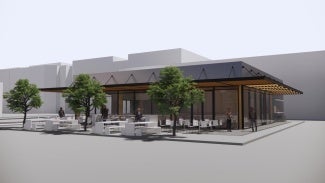
Five ways to maximize the value of value engineering
Despite high estimates and construction bids for your projects, value engineering can help keep your efforts alive. Here are five ways to make the most of the process.

The mere mention of value engineering may send chills down your spine, but the exercise can be invaluable to any worker in an industry subject to market forces, inflation surges, and supply chain disruptions. A project that has been in design for multiple years might go to bid just as a crucial commodity reaches a record high, upending the best-laid plans for optimization. The cost of lumber famously leaped by more than 400% between 2020 and 2021, before settling down to its current rate of approximately 70% higher than pre-pandemic times.
Though architects have weathered numerous ups and downs in the economy, the current period seems unprecedented, says Patrick Todd, director of architecture at the San Jose office of RMW Architecture & Interiors. The industry used to be able to trend material costs and labor costs, he says: “Now there are so many variables for each project, and the variability is a challenge.”
Todd’s sentiments are echoed by Roark Redwood, AIA, CannonDesign’s principal and executive director of operations for architecture, engineering, and interiors. “Compared to past economic cycles, what we have seen is heightened volatility,” he says. The stock market, for instance, has swung by several percentage points in either direction from week to week in recent years. The rattled financial industry has tightened lending practices, he adds, and the imminent elections have created an environment of “wait-and-see.”
Meanwhile, many manufacturers haven’t resumed their pre-pandemic model of stocking warehouses with inventory. “Now, the shelves are bare and they’re only building or manufacturing things in times of need,” Todd says. “Even if something is manufactured locally, its parts are coming from different parts of the world.” Labor costs are another wildcard. “Labor halls were once full of people,” he continues. “Now it’s a struggle to fill the roles that are needed for projects.”
These compounding factors can lead to what can seem like astoundingly high estimates and construction bids for your projects. But value engineering can help keep your efforts alive. Here are five ways to make the most of the process.
Change the mindset
First, consider value engineering a positive endeavor. “I don’t think value engineering should be a bad [term],” Todd says. In fact, he believes the process would be better described as “value design.” “It’s not just slashing and cutting costs,” he says. “If you have a solid design, you should be able to make adjustments and fine-tune it.”
Redwood prefers the term “value analysis”: “It’s more about allocating the funds in the right places in the right way, and de-allocating [money in areas that are] not a high priority or a high- value outcome,” he says.
With all the forces exerting pressure on the industry, architects should not feel frustrated or embarrassed if construction bids exceed their clients’ budget. Every project can benefit from a value design or a value analysis—and it shouldn’t wait until after bids come back.
Hold the tough conversations early and often
The design process can span years. Developing a relationship with the client that supports transparent and honest conversations will be mutually beneficial. “Communicating a lot more than we think is necessary is the right amount,” advises Pete Fowler, founder and chief quality officer of Pete Fowler Construction Services.
Nailing down client budget, budget flexibility, and project goals and expectations needs to happen at the project start. Understand which project aspects are must-haves or nice-to-haves and hold regular check-ins throughout the project lifecycle. Budgets and priorities can shift significantly over time.
Delivery models such as design-build and integrated project delivery encourage involving consultants, engineers, contractors, and end users as early as possible in planning and design. Buildings are too complex for architects to know every cost-saving opportunity. The more input and feedback shared, the more likely the outcome will meet client expectations.
Multidisciplinary discussions can even begin prior to the design kickoff, Todd says: “We don’t want to get into a position where everybody falls in love with the design, but then … the design is too costly and we have to scale it back for whatever reason.”
Similarly, Redwood advises learning which “spaces and experiences [the client] cannot compromise on” and which they recognize as “not needing the highest-level finish or material.”
Ask for help in numbers
Cost estimates are no longer something about which one can accurately have a gut feeling. Though longstanding resources, like RSMeans, can provide a starting point, wild swings in prices due to regionality and timing can throw numbers off. “Construction cost estimating is a hyper specialty—something that people dedicate their lives to,” Fowler says. Individuals certified by the American Society of Professional Estimators must earn professional development units each year, for example, and seasoned cost consultants will possess a mixture of training, experience, and technical skill.
Soliciting cost estimates early and often “is the best way to keep the costs of design down,” Redwood says. A good cadence might be at the end of each design phase—schematic design, design development, and construction documents—or, better yet, at the midpoint and completion of each phase.
Cost consultants can become involved in a project in several ways. Many large firms have in-house cost-estimating talent who can work alongside the design staff “as an interactive member of your team,” Redwood says.
Small firms might not have a cost estimator on staff, but they can advocate for an owner to hire a cost consultant. “A little investment upfront is going yield a lot of savings at the end,” Redwood says. “Any change you make in design is miniscule [in costs compared] to a correction in the field or, even worse, once it’s occupied and being maintained.”
Architects can also encourage owners to hire a local general contractor for preconstruction services. “Estimating in the quiet of one’s office doesn’t always extrapolate to exactly what happens in the marketplace,” Fowler says. That contractor may also formally bid on the project when the time comes.
“Contractors know the market and what they’ve been building,” Todd says. “They can talk to their subs and see where [costs] are heading based on their experience and previous work.” His firm also relies on technical consultants, like their engineers, to provide feedback on building system options and drivers that sway costs.
Unlike builders, who are constantly running the numbers, architects typically do not regularly or proactively run price checks on their designs. But more owners are seeing the value of cost estimating, Redwood says. “Even in the private sector,” he says, “many intelligent clients are realizing the benefit of architects and engineers bringing estimating into the project early and often.”
Avoid shortcuts when seeking savings
Despite your best efforts, you and your client may still face sticker shock when bids are opened. But if you have conducted your due diligence throughout design, you should know which project aspects hold the most value to the client and which building systems and components offer savings opportunities.
Focusing on the highest first costs can be tempting, but hasty decisions can cost your client more in the long run due to maintenance or replacement expenses. For example, the building envelope, MEP systems, and lighting are common starting points because they represent sizeable investments, but architects should not downgrade these systems automatically. “Lighting is a huge cost,” Redwood acknowledges, “but it’s also a huge factor in the quality of experience.”
Conveyance systems can present savings because pricing can vary among manufacturers, Todd says. However, like Redwood, he advises keeping long-term operational costs in mind. “Jurisdictions are mandating sustainability requirements, such as [California’s] Title 24,” Todd says. “Now that [sustainability] has become a bigger piece of your pie, you have to factor those costs into the project.”
As Fowler puts it, short-term thinking can lead to a “fancy outside and crappy carpet inside because you didn’t make great decisions throughout the process.” If your client opts for substitutions in materials or methods despite your advice, he says, make sure to document everything in writing. Substitutions can be sensible, but a proposal to switch products should be thoroughly vetted.
And again, architects should view the process as enhancing their projects’ value rather than as a rash cost-cutting measure. Todd recalls a project where the design called for a canopy of wood battens that elegantly wrapped the building. To preserve the look, the owner would have to maintain the wood regularly—something they expressly did not want to do. As an alternative, Todd and his team found an aluminum system with a realistic wood finish, which did not necessarily have a lower initial cost but would save the owner on maintenance expenses for years thereafter. “These are the discussions you need to have from day one,” Todd says.
Stay apprised of your surroundings
Staying informed on market fluctuations, labor and material costs, and business news can help you land your projects near their target budget. Redwood, for one, regularly reads reports from AIA, such as the Architecture Billings Index, and industry publications, including Architect, Architectural Record, and Engineering News Record. He also pores over business publications, such as Barron’s and The Wall Street Journal.
Regardless of how you refer to value engineering, design optimization can be a beneficial exercise for any project. “It helps the owners keep the functions and key aesthetics that they want, while increasing efficiency, typically, and reducing costs,” Redwood says. When done with the input of all stakeholders throughout the project’s evolution, the efforts are almost certain to pay off.
Wanda Lau is a freelance writer based in Chicago covering architecture and design.



